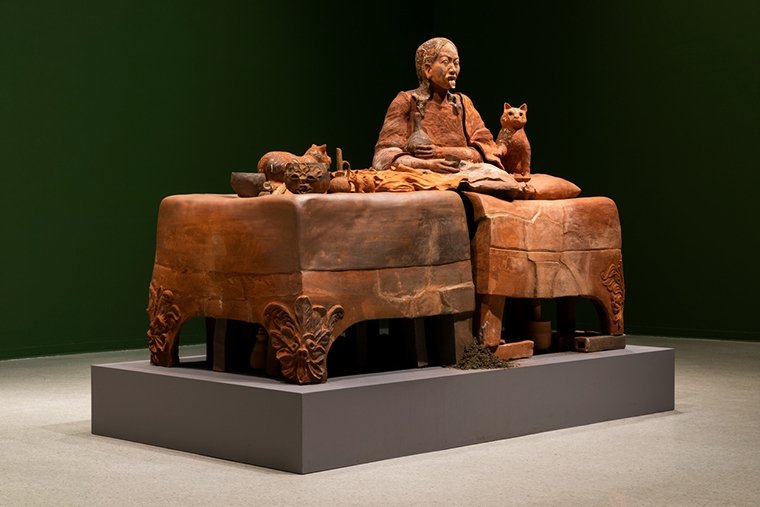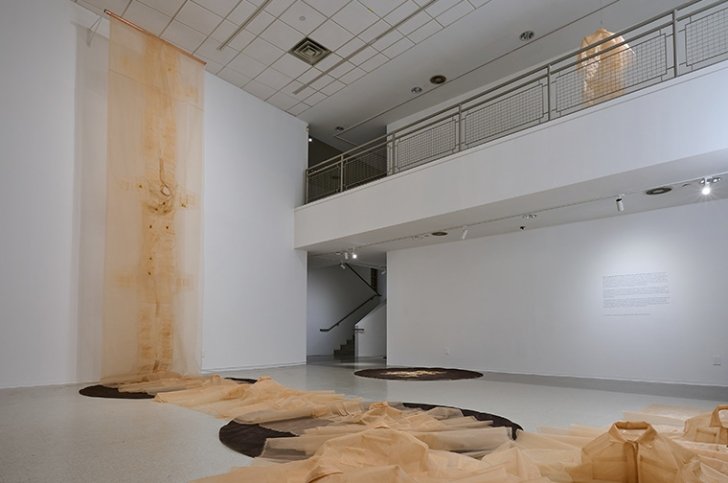Candice Lin - Natural History: A Half-Eaten Portrait, an Unrecognizable Landscape, a Still, Still Life
January 25 - March 26, 2020

The exhibition comprises a full-scale ceramic representation of Candice Lin reclining with her future cat. Lin’s monumental ceramic sculpture references the history of clay sarcophagi, specifically the Etruscan terracotta funerary sculptures from the 9th through 2nd centuries BCE, famously life-sized and often featuring a man and a woman reclining together. Renowned for their naturalistic representations of the human form, Etruscans practiced the tradition of interring the body, with animal companions or objects that held particular significance to the deceased, within a sarcophagus. Lin imagines housing her own decomposing body and that of the cat that she lives with at the time of her death within this sculptural memento mori. In addition to exploring ideas around mortality and interment, Lin’s installation considers existence and futurity from a post-human perspective by linking the longevity of clay—the life-span of fired ceramics can be thousands of years—with other organic life-cycles. Like historical sarcophagi, where the outstretched limbs of the figures would have once held vessels containing foods or precious objects, Lin’s sculpture will portray her and her cat accompanied by vessels containing preserved plants, seeds, and minerals.
Complementing the life-size sarcophagus (self-portrait of Lin and her cat), are a series of illuminated glass aquariums, set onto metal stands. Mimicking museological display cases, these vitrines house colonies of Dermestid “flesh-eating” beetles, which will consume a series of works resembling human bones. These objects have been fabricated from a commercial meat-paste substitute combined with Lin’s own dried skin and fingernails. Used in museums for cleaning bones and carcasses for display and research, these carnivorous insects have been employed by Lin to suggest an effective interspecies collaboration—a subject that underpins much of Lin’s practice. By cultivating this family of beetles, which over generations will learn to survive and thrive on this diet, Lin creates a sub-population predisposed to thrive while her own body decays. Requiring constant caretaking, and the harvesting of her own skin, these beetles serve as active reminders of our mortality.
The materials used by Lin are part of her ongoing research into the histories of colonial trade objects such as porcelain, silk, opium, abortifacient plants, poisons, and cochineal in relation to discourses around whiteness, exoticism, race, and othering. While earlier works focused on the acquisition and exploitation of non-Western botanical and biological processes, this exhibition examines the institutional framing by museums of historical artefacts and organic material—be they sarcophagi or body parts—through their collection and display technologies and by doing so reveals how these systems configure knowledge.
About the artist
Candice Lin (b. 1979, Concord, Massachusetts) works in Altadena, California. She received her BA in both visual arts and semiotics from Brown University, in 2001, and MFA in New Genres from San Francisco Art Institute, in 2004. Her work has been exhibited at the UCLA Hammer Museum (2018); Portikus, Frankfurt (2018); Moderna Museet, Stockholm (2017); Bétonsalon—Center for Art and Research, Paris (2017); Human Resources, Los Angeles (2017); New Museum, New York (2017); SculptureCenter, Long Island City, New York (2017); Los Angeles Contemporary Exhibitions (2016); and Vincent Price Art Museum, Los Angeles (2013), among others. She is the recipient of several residencies, grants, and fellowships, including a California Community Foundation Award (2014), Fine Arts Work Center Residency (2012), Frankfurter Kunstverein Deutsche Börse Residency (2010), and Smithsonian Artist Research Fellowship (2009).
Curator
Candice Lin - Natural History: A Half-Eaten Portrait, an Unrecognizable Landscape, a Still, Still Life is curated by Ciara Ennis, Director and Curator of Pitzer College Art Galleries. Ennis received a PhD in Cultural Studies and Museum Studies from Claremont Graduate University and an MA in Visual Arts Administration, Curating, and Commissioning Contemporary Art from the Royal College of Art, London.
This exhibition is generously supported by the Pitzer College Ceramics Studio and Residency.
In the News
Artists at Work: Candice Lin, by Silvi Naçi, in East of Borneo
Review: Candice Lin, by Kay Whitney, in Sculpture magazine
Related Events
Candice Lin Artist Talk
Co-hosted by Pitzer College Ceramics Studio
Thursday, February 20, 2020, 1:45 pm
Nichols Gallery
Candice Lin in conversation with Kyla Wazana Tompkins, Pomona College professor of English and Gender and Women's Studies
Thursday, February 27, 2020, 1:45 pm
Nichols Gallery
Image Caption
Installation view of Candice Lin- Natural History: A Half-Eaten Portrait, an Unrecognizable Landscape, a Still, Still Life at Pitzer College Art Galleries, January 25 - March 26, 2020. Photograph courtesy of Ruben Diaz.

